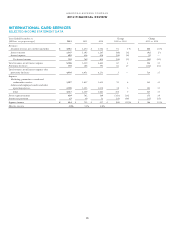American Express 2012 Annual Report Download - page 41
Download and view the complete annual report
Please find page 41 of the 2012 American Express annual report below. You can navigate through the pages in the report by either clicking on the pages listed below, or by using the keyword search tool below to find specific information within the annual report.AMERICAN EXPRESS COMPANY
2012 FINANCIAL REVIEW
risks. This framework, supervised by the ORMC, consists of
(a) operational risk event capture, (b) a project office to
coordinate issue management and control enhancements, (c) key
risk indicators such as customer complaints or pre-
implementation test metrics, and (d) process and entity-level risk
self-assessments.
The framework requires the assessment of operational risk
events to determine root causes, customer impacts and
resolution plan accountability to correct any defect, remediate
customers, and enhance controls and testing to mitigate future
issues. The impact on the Company is assessed from an
operational, financial, brand, regulatory compliance and legal
perspective.
COMPLIANCE RISK MANAGEMENT PROCESS
The Company defines compliance risk as the risk of legal or
reputational harm, fines, monetary penalties, payment of
damages or other forms of sanction as a result of non-
compliance with applicable laws, regulations, rules or standards
of conduct.
The Company views its ability to effectively mitigate
compliance risk as an important aspect of its business model.
The Company’s Global Compliance and Ethics organization is
responsible for establishing and maintaining the Company’s
Corporate-wide Compliance Risk Management Program.
Pursuant to this program, the Company seeks to manage and
mitigate compliance risk by assessing, controlling, monitoring,
measuring and reporting the regulatory risks to which it is
exposed.
The Audit, Risk and Compliance Committee of the Board of
Directors is responsible for approving key compliance policies
following their review by the ERMC and for reviewing the
effectiveness of the Corporate-wide Compliance Risk
Management Program across the Company’s business functions.
In addition, the Audit, Risk and Compliance Committee
approves the Company’s compliance risk tolerance statement,
which reinforces the importance of compliance risk management
at the Company.
REPUTATIONAL RISK MANAGEMENT PROCESS
The Company defines reputational risk as the risk that negative
public perceptions regarding the Company’s products, services,
business practices, management, clients and partners, whether
true or not, could cause a decline in the customer base, costly
litigation, or revenue reductions.
The Company views protecting its reputation as core to its
vision of becoming the world’s most respected service brand and
fundamental to its long-term success.
General principles and the overall framework for managing
reputational risk across the Company are defined in the
Reputational Risk Management Policy. The Reputational Risk
Management Committee is responsible for implementation of
and adherence to this policy, and for performing periodic
assessments of the Company’s reputation and brand health based
on internal and external assessments.
Business leaders across the Company are responsible for
ensuring that reputation risk implications of transactions,
business activities and management practices are appropriately
considered and relevant subject matter experts are engaged as
needed.
MARKET RISK MANAGEMENT PROCESS
Market risk is the risk to earnings or value resulting from
movements in market prices. The Company’s market risk
exposure is primarily generated by:
폷Interest rate risk in its card, insurance and Travelers Cheque
businesses, as well as in its investment portfolios; and
폷Foreign exchange risk in its operations outside the United
States.
Market Risk limits and escalation triggers within the Market
Risk and Asset Liability Management Policies are approved by
the Audit, Risk and Compliance Committee of the Board of
Directors and ALCO. Market risk is centrally monitored for
compliance with policy and limits by the Market Risk
Committee, which reports into the ALCO and is chaired by the
Chief Market Risk Officer. Market risk management is also
guided by policies covering the use of derivative financial
instruments, funding and liquidity and investments.
The Company’s market exposures are in large part by-
products of the delivery of its products and services. Interest rate
risk arises through the funding of cardmember receivables and
fixed-rate loans with variable-rate borrowings as well as through
the risk to net interest margin from changes in the relationship
between benchmark rates such as Prime and LIBOR.
Interest rate exposure within the Company’s charge card and
fixed-rate lending products is managed by varying the
proportion of total funding provided by variable-rate debt and
deposits compared to fixed-rate debt and deposits. In addition,
interest rate swaps are used from time to time to effectively
convert fixed-rate debt to variable-rate or to convert variable-
rate debt to fixed-rate. The Company may change the mix
between variable-rate and fixed-rate funding based on changes in
business volumes and mix, among other factors.
The Company does not engage in derivative financial
instruments for trading purposes. Refer to Note 12 to the
Consolidated Financial Statements for further discussion of the
Company’s derivative financial instruments.
As of December 31, 2012, the detrimental effect on the
Company’s annual net interest income of a hypothetical 100
basis point increase in interest rates would be approximately
$223 million. To calculate this effect, the Company first
measures the potential change in net interest income over the
following 12 months taking into consideration anticipated future
business growth and market-based forward interest rates. The
Company then measures the impact of the assumed forward
interest rate plus the 100 basis point increase on the projected
net interest income. This effect is primarily driven by the volume
of charge card receivables and loans deemed to be fixed-rate and
funded by variable-rate liabilities. As of December 31, 2012, the
39
























